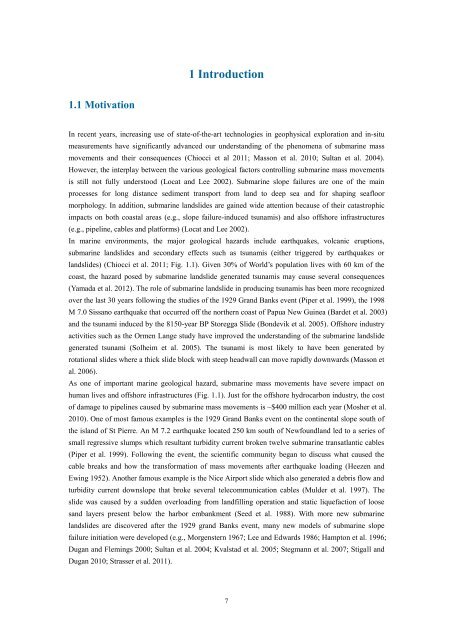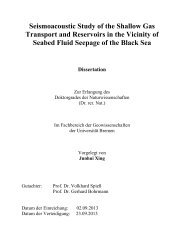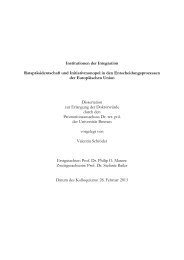Slope stability along active and passive continental margins ... - E-LIB
Slope stability along active and passive continental margins ... - E-LIB
Slope stability along active and passive continental margins ... - E-LIB
Create successful ePaper yourself
Turn your PDF publications into a flip-book with our unique Google optimized e-Paper software.
1 Introduction<br />
1.1 Motivation<br />
In recent years, increasing use of state-of-the-art technologies in geophysical exploration <strong>and</strong> in-situ<br />
measurements have significantly advanced our underst<strong>and</strong>ing of the phenomena of submarine mass<br />
movements <strong>and</strong> their consequences (Chiocci et al 2011; Masson et al. 2010; Sultan et al. 2004).<br />
However, the interplay between the various geological factors controlling submarine mass movements<br />
is still not fully understood (Locat <strong>and</strong> Lee 2002). Submarine slope failures are one of the main<br />
processes for long distance sediment transport from l<strong>and</strong> to deep sea <strong>and</strong> for shaping seafloor<br />
morphology. In addition, submarine l<strong>and</strong>slides are gained wide attention because of their catastrophic<br />
impacts on both coastal areas (e.g., slope failure-induced tsunamis) <strong>and</strong> also offshore infrastructures<br />
(e.g., pipeline, cables <strong>and</strong> platforms) (Locat <strong>and</strong> Lee 2002).<br />
In marine environments, the major geological hazards include earthquakes, volcanic eruptions,<br />
submarine l<strong>and</strong>slides <strong>and</strong> secondary effects such as tsunamis (either triggered by earthquakes or<br />
l<strong>and</strong>slides) (Chiocci et al. 2011; Fig. 1.1). Given 30% of World’s population lives with 60 km of the<br />
coast, the hazard posed by submarine l<strong>and</strong>slide generated tsunamis may cause several consequences<br />
(Yamada et al. 2012). The role of submarine l<strong>and</strong>slide in producing tsunamis has been more recognized<br />
over the last 30 years following the studies of the 1929 Gr<strong>and</strong> Banks event (Piper et al. 1999), the 1998<br />
M 7.0 Sissano earthquake that occurred off the northern coast of Papua New Guinea (Bardet et al. 2003)<br />
<strong>and</strong> the tsunami induced by the 8150-year BP Storegga Slide (Bondevik et al. 2005). Offshore industry<br />
activities such as the Ormen Lange study have improved the underst<strong>and</strong>ing of the submarine l<strong>and</strong>slide<br />
generated tsunami (Solheim et al. 2005). The tsunami is most likely to have been generated by<br />
rotational slides where a thick slide block with steep headwall can move rapidly downwards (Masson et<br />
al. 2006).<br />
As one of important marine geological hazard, submarine mass movements have severe impact on<br />
human lives <strong>and</strong> offshore infrastructures (Fig. 1.1). Just for the offshore hydrocarbon industry, the cost<br />
of damage to pipelines caused by submarine mass movements is ~$400 million each year (Mosher et al.<br />
2010). One of most famous examples is the 1929 Gr<strong>and</strong> Banks event on the <strong>continental</strong> slope south of<br />
the isl<strong>and</strong> of St Pierre. An M 7.2 earthquake located 250 km south of Newfoundl<strong>and</strong> led to a series of<br />
small regressive slumps which resultant turbidity current broken twelve submarine transatlantic cables<br />
(Piper et al. 1999). Following the event, the scientific community began to discuss what caused the<br />
cable breaks <strong>and</strong> how the transformation of mass movements after earthquake loading (Heezen <strong>and</strong><br />
Ewing 1952). Another famous example is the Nice Airport slide which also generated a debris flow <strong>and</strong><br />
turbidity current downslope that broke several telecommunication cables (Mulder et al. 1997). The<br />
slide was caused by a sudden overloading from l<strong>and</strong>filling operation <strong>and</strong> static liquefaction of loose<br />
s<strong>and</strong> layers present below the harbor embankment (Seed et al. 1988). With more new submarine<br />
l<strong>and</strong>slides are discovered after the 1929 gr<strong>and</strong> Banks event, many new models of submarine slope<br />
failure initiation were developed (e.g., Morgenstern 1967; Lee <strong>and</strong> Edwards 1986; Hampton et al. 1996;<br />
Dugan <strong>and</strong> Flemings 2000; Sultan et al. 2004; Kvalstad et al. 2005; Stegmann et al. 2007; Stigall <strong>and</strong><br />
Dugan 2010; Strasser et al. 2011).<br />
7
















